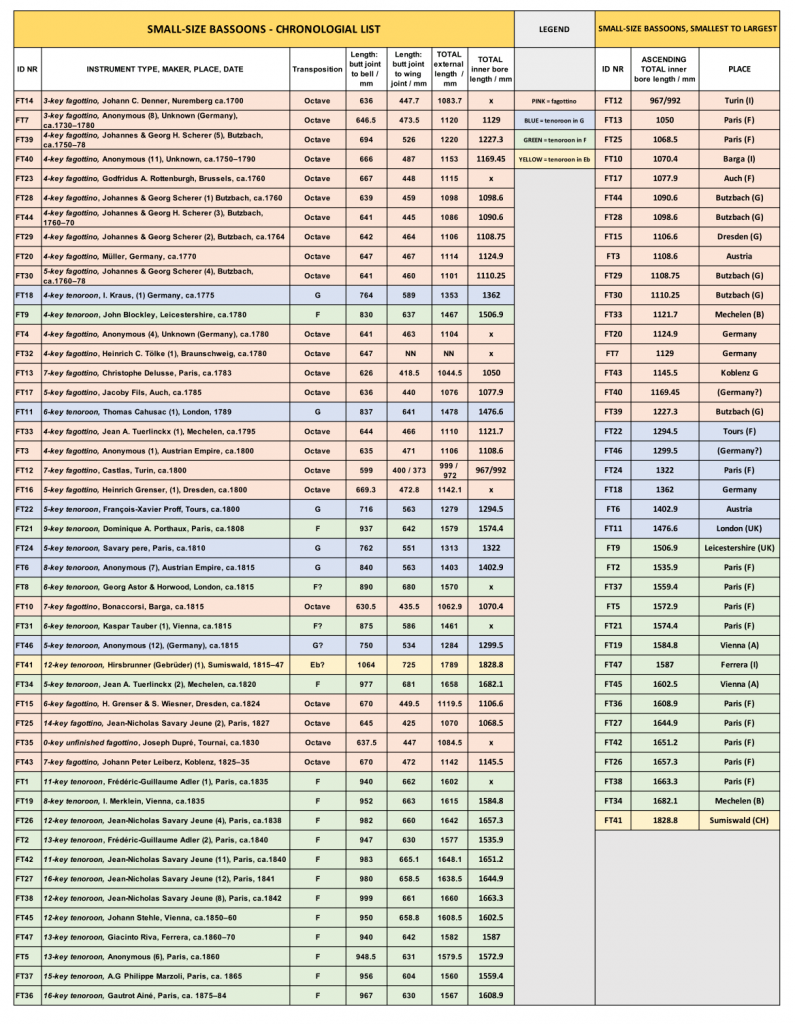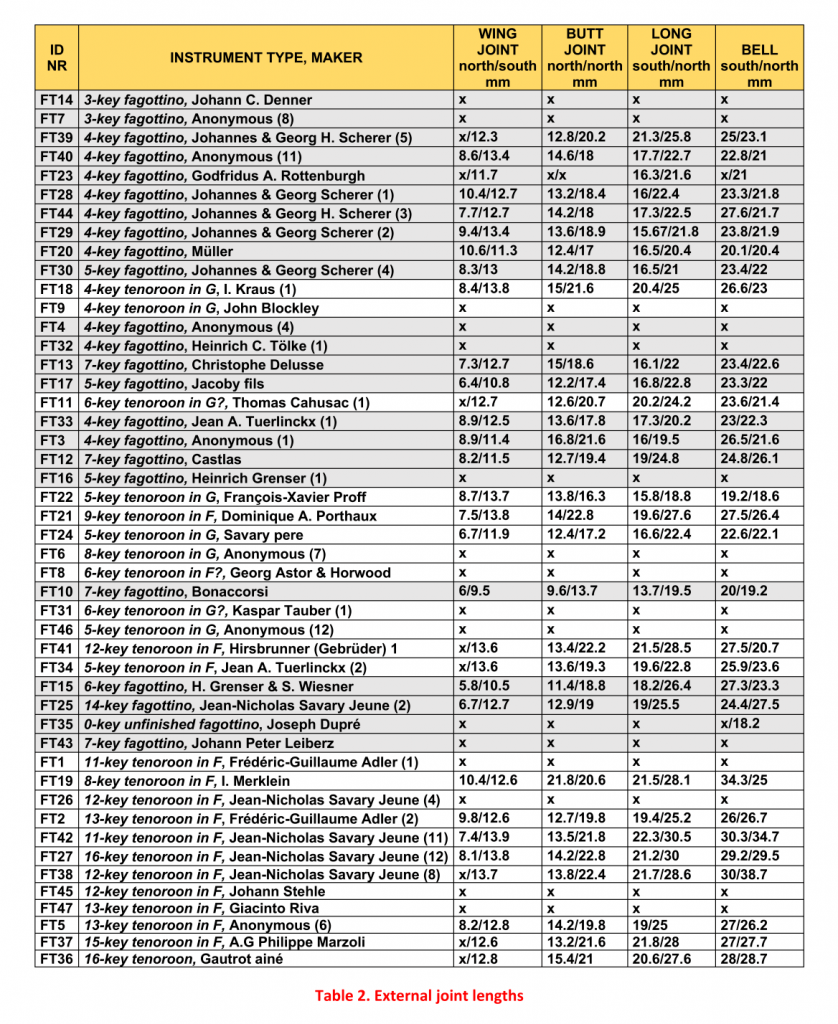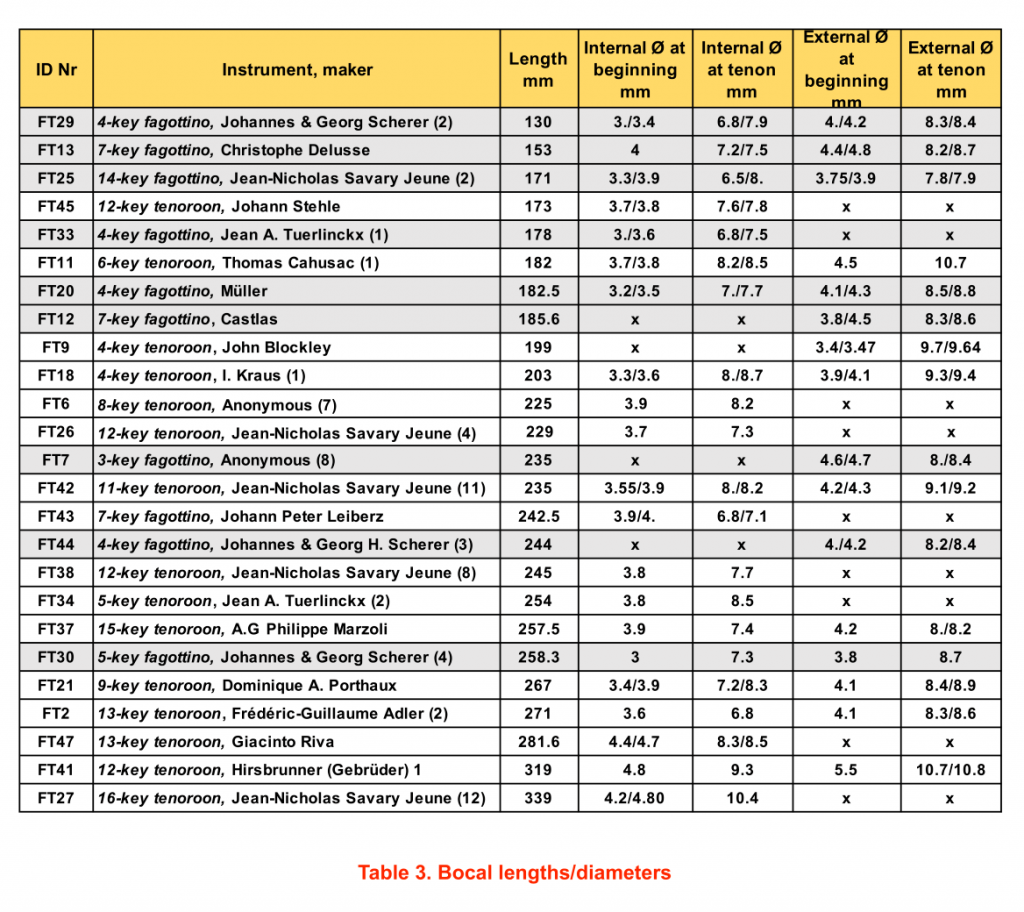Measurement comparisons
The following tables offer an overall picture of some of the most important measurements of the examined instruments. This data can be compared on different levels, for example according to a chronological order and/or a geographical scheme. Some sizes of instruments can be easily compared to instruments made by the same builder, or to instruments made by their contemporaries, for example.
Table 1
Standing lengths, chronologically ordered and smallest to largest
A chronological display of instrument types, standing lengths, total external lengths and inner bore lengths is an important guideline to compare how many of these major measurements differ over the decades. The list shows the popularity of instrument types from ca. 1700 to ca. 1900. The last two columns offer an overview of the total bore lengths, from the smallest to the largest. Considering these columns, it is evident that there is a constant measurement range in which the category of fagottini can be found, and the same can be said for tenoroons in G and F.
Note: Total internal bore lengths are calculated using: internal bore lengths of the wing joint (including bocal well), butt joint (big and small bores), long joint and bell, minus socket lengths of the big and small bores in the butt joint, as well as the bell socket. A calculated allowance of septum space for fagottino (25 mm) and tenoroon (35 mm) is added.
Details
- Fagottini have a total internal bore length between ca. 971 mm (FT12 Castlas) and ca. 1227.3 mm (FT39 Scherer). The range is ca. 972 mm–1220 mm, using the external length.The “fagottino median” calculated within all available bore total lengths (without any geographical or chronological ranking) is ca. 1098.7 mm. This value corresponds to the total bore length of FT28 Scherer 1.
- Tenoroons in G have a total internal bore length within a range between ca. 1294.5 mm (FT22 Proff) and ca. 1476.6 mm (FT11 Cahusac). The range is ca. 1279 mm–1478 mm, considering external length. The “tenoroon median in G” calculated within all the available bore total lengths (without any geographical or chronological ranking) is ca. 1359.6 mm.
- Tenoroons in F are those instruments with a total internal bore length within a range
between ca. 1506.9 mm (FT9 Blockley) and ca. 1682.1 (FT34 Tuerlinckx). The range is ca. 1467 mm–1658 mm, considering external length. The “tenoroon median in F” calculated within all the available bore total lengths (without any geographical or chronological ranking) is ca. 1602.2 mm. This value corresponds the total bore length of FT45 Stehle.
According to studies of Giovanni Battista Graziadio, total bore lengths in fagottini generally correspond to ca. half of the total bore length of the full-size bassoon made by the same maker; tenoroons in G generally have slightly less than 3/4 of the total bore length of the full-size bassoon made by the same maker; tenoroons in F, generally slightly more than 3/4 of the total bore length of the full size bassoon made by the same maker.

Table 2
Comparison of bore diameters of single joints (smallest and largest diameters)
Table 2 gives rough information on how conicity is different or similar when considering bore diameters of joints of different instruments having similar lengths, approximating bores to regular conic sections and ignoring how the diameter progressions along the bores can vary. In this instance and using this table, more conjectures can be made if the instruments come from same region and/or period. The volume of air put in vibration is what is significant for pitch/tone with instruments having similar bore lengths.The volume of air of each joint (and of the whole instrument) is directly proportional to the length of each joint, but it is even more proportional to the diameters of beginnings and ends of each bore. In any case, for more profound information of the design of bores, please consult our bore measurement collection in the instrument datasets located under “Instruments” / “Datasets – links to Zenodo”.

Table 3
Bocal lengths and diameters: shortest to longest
From Table 3, we see that there is a large range of bocal dimensions of those located with the examined small-size bassoons. It is impossible to confirm if all bocals have remained with the instruments they were built for (the only real test being by playing), but of the three bocals located with Scherer fagottini, two are similar to each other: FT44 (244 mm) and FT30 (258.3 mm). These kinds of comparisons can also be made with Savary Jeune bocals and others.
Bocal and reed dimensions are complementary, influencing overall pitch, tuning, response, and tone quality. These pieces are generally chosen according to the individual player’s requirements, and can therefore vary substantially.
An interesting investigation can be done by calculating the median of bocals which come with different types of instruments.
Lengths
Fagottino: The shortest fagottino bocal belongs to FT29 Scherer (130 mm), and the longest, to FT30 Scherer (258.3 mm). The “fagottino bocal median” calculated from all available fagottino bocal lengths (without any geographical or chronological ranking) is ca. 198 mm.
G tenoroon: There are just three bocals with G tenoroons: FT11 (182 mm), FT18 (203 mm), FT6 (225 mm). The “G tenoroon bocal median” calculated from all the available G tenoroon bocal lengths (without any geographical or chronological ranking) is ca. 203.333… mm which can be approximated to the FT18 bocal length.
F tenoroon: The shortest F tenoroon bocal belongs to FT45 Stehle (173 mm) and the longest, to FT27 Savary Jeune (339 mm). The “F tenoroon bocal median” calculated from all the available F tenoroon bocal lengths (without any geographical or chronological ranking) is ca. 252 mm.
Diameters
Fagottino: The median of the diameters at the beginning is 3.57 mm; the smallest diameter is 3 mm in FT30 Scherer, and largest is 4.35 mm in FT7. The median of the diameters at the tenon is 7.4 mm; the smallest is 6.95 mm (FT43 Leiberz) and largest is 7.95 mm (FT44 Scherer).
G tenoroon: The median of the diameters at the beginning 3.7 mm; the smallest diameter is 3.45 mm (FT18 Kraus) and largest is 3.9 mm (FT6 Anonymous). The median of the diameters at the tenon is 8.3 mm and is the same value (8.35 mm) for FT18 Kraus and FT11 Cahusac.
F tenoroon: The median of the diameters at the beginning is 3.93 mm; the smallest is 3.6 mm (FT2 Adler) and largest is 4.55 mm (FT47 Riva). The median of the diameters at the tenon is 8 mm; the smallest is 6.8 mm (FT2 Adler) and the largest is 10.4 mm (FT27 Savary Jeune).
